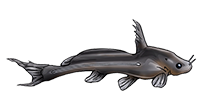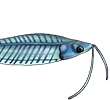/siluriformes/pseudopimelodidae/lophiosilurus/fowleri/1.jpg)
Rusty Jelly Catfish, Orange Catfish, Oremon Catfish, Pocoma (Brazilian) - Lophiosilurus fowleri (Haseman, 1911)
Article © Julian Dignall, uploaded August 01, 2006.
Odd things happen in fishkeeping. For example, our often irrational attachment and sense of character that we interpret from the habits of the fish we keep; this leads us to name our pets and associate human traits with them too. One such group of fish that recive this treametment are those larger members of the family Pseudopimelodiae. Amongt them is the uncommonly seen Orange, or Rusty, Jelly Catfish also know as the Oremon Catfish and formally as Cephalosilurus fowleri. The species was resurrected to Cephalosilurus in the 1990's after spending decades in the genus Pseudopimelodus, so you may be more familiar with that name. From an external point of view Cephalosilurus, at least as younger fish, have dark caudal fins, Pseudopimelodus species do not and also have a layer of skin over their pectoral fin spines in adulthood.
Jelly cats are so called because, especially as they mature, they are gelatinous sausage like blobs of fish that look like those weird creatures that live in the deepest, darkest parts of the ocean rather than something you would expect to encounter in an unassuming tropical fish tank. Incidentally, Jelly in UK English means what North Americans would call Jello; Jelly in US English means what the European English speakers would call Jam. So, if you're talking about this fish in the States, it's really a Jello Cat! In South America they have a number of common names too, but my favourite is bagre sapo - toad catfish.
Confusing multiple common names aside, this species is one of many distinctive species that come from the Rio Sao Francisco river system. The Rio Sao Francisco is the fourth largest river system in South America and the longest river wholly within Brazil. Many of its fishes are not found in other river systems and this lump of an orange catfish is one of them. I chose to write about this species as opposed to other similar ones as it is the most attractive (at least in terms of being a nice rusty orange colour - this fish stayed at home when graceful looks were being handed out) and so is readily identifiable.
Husbandry of this species is simple. Feed it sparingly and keep its tank clean. Although growing to well over a foot, as it's a natural "couch potato", it can be housed adequately in larger standard size aquaria. It will however, attempt to eat anything it is kept with. Adult fishes, especially females, get particularly aggressive even to their own kind - this might be an offshoot of their mode of reproduction - while it hasn't been documented in aquaria, it appears from field observations this fish practices at least limited care of a brood reared in shallow gravel depressions the fishes dig out themselves - no other fishes are tolerated in this zone. Thus filtration should be external as this fish likes nothing better than to dig itself in a pit of gravel and wait for lunch to swim by. Actually, that's about it as far as keeping this fish goes. Buy it, feed it, watch it grow fat - but I bet you name it too!
Copyright information for the images used in this article can be found on the species' full Cat-eLog page.
| Scientific Name | Lophiosilurus fowleri (Haseman, 1911) |
| Common Names | Rusty Jelly Catfish Orange Catfish, Oremon Catfish, Pocoma (Brazilian) |
| Type Locality | Rio São Francisco, Cidade de Barra, Bahia, Brazil. |
| Synonym(s) | Cephalosilurus fowleri, Pseudopimelodus fowleri |
| Pronunciation | foul err eye |
| Etymology | Greek, lophos = crest + Greek, silouros = cat fish -> Crested catfish. Named for the prolific ichthyologist, Henry Fowler. |
| Articles | |
| Size | 405mm or 15.9" SL. Find near, nearer or same sized spp. |
| Identification | Larger and with a more orange colouration than C. apurensis. |
| Sexing | Females larger and much more aggressive, very distinguishable dimorphism by venting especially at larger sizes. |
| Distribution | South America: São Francisco River basin, Brazil. São Francisco (click on these areas to find other species found there) Login to view the map. |
| IUCN Red List Category | Not Evaluated |
| Temperature | 23.0-27.0°C or 73.4-80.6°F (Show species within this range) |
| Feeding | Fish (fresh and frozen), krill, shrimp, earthworms, mice, rats, sinking pellets, shrimp pellets, any "meaty" type foods with a little variety thrown in. User data. |
| Furniture | Caves, driftwood, sand, floating plants. |
| Compatibility | Very aggressive and not shy. |
| Suggested Tankmates | Best kept alone or in the most bullish of considerably larger company. |
| Breeding | Unreported. |
| Breeding Reports | There is no breeding report. |
| Reference | Annals of the Carnegie Museum v. 7 (nos 3-4) (17), pp 317, Pl. 46. |
| Registered Keepers | There are 8 registered keepers, view all "my cats" data. |
| Wishlists | Love this species? Click the heart to add it to your wish list. There are 4 wishes to keep this species, see who wants what. |
| Spotters | Spotted this species somewhere? Click the binoculars! There are 9 records of this fish being seen, view them all. |
| Forum BBCode | |
| Search for L. fowleri | |
| Look up L. fowleri on AquaticRepublic.com | |
 | Look up L. fowleri on Fishbase |
 | Look up L. fowleri on Encyclopedia of Life |
 | Look up L. fowleri on Global Biodiversity Information Facility |
| LFS label creator ARN ref:1.31.232.1087 | |
| Last Update | 2022 Apr 18 04:02 (species record created: 2006 Aug 01 11:22) |
Back to Catfish of the Month index.




